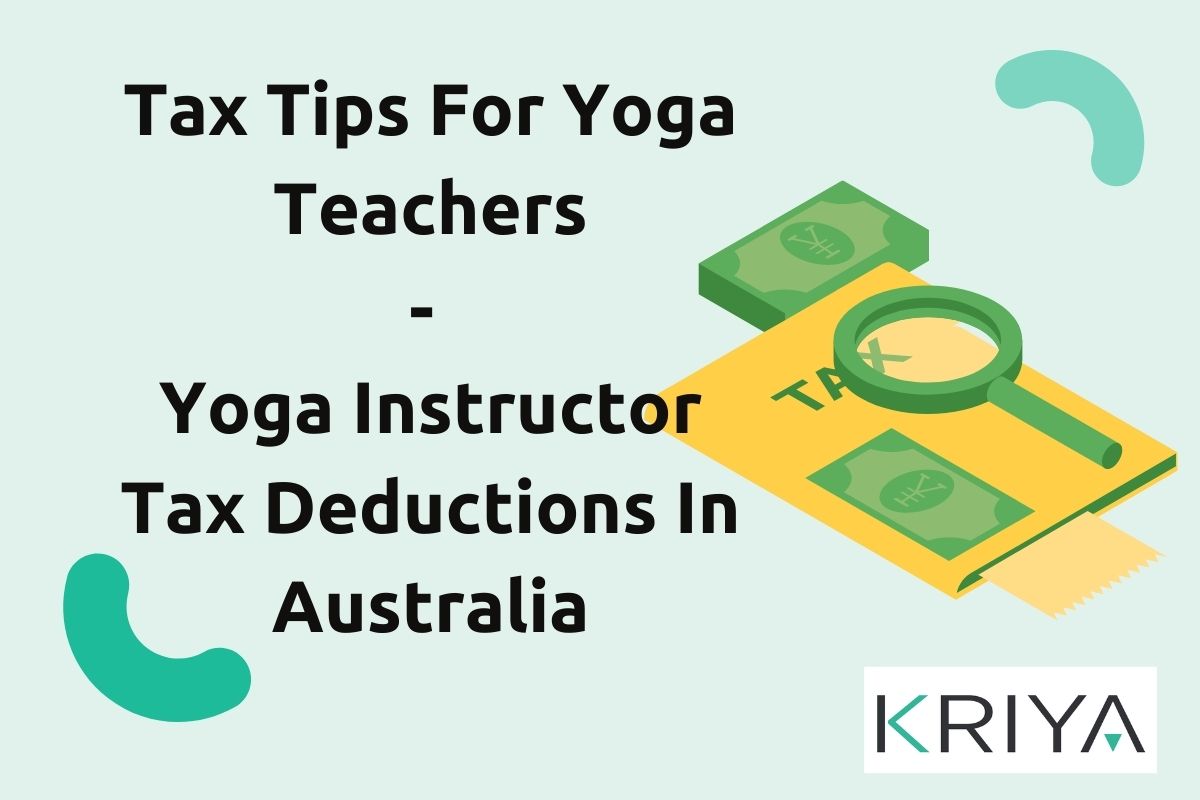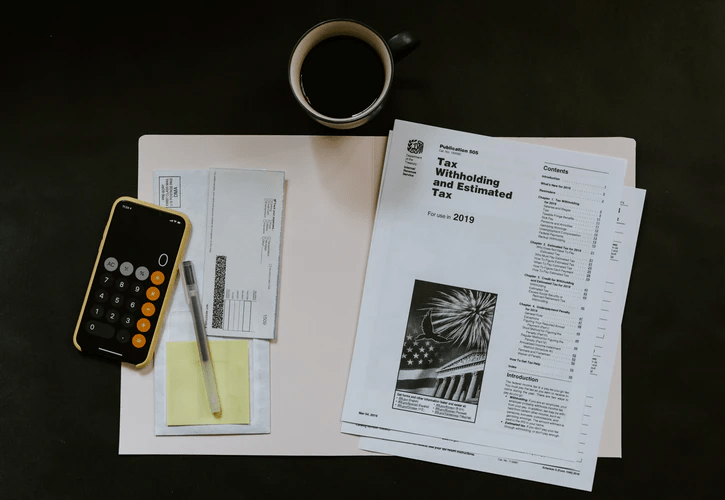
Tax Tips For Yoga Teachers – Yoga Instructor Tax Deductions In Australia
Yoga is a business, and businesses have to pay taxes. Yoga studios must pay their utility bills, insurance, taxes, and licensing fees. If you own a Yoga studio or are employed as a yoga teacher in a yoga studio or business, you must pay taxes. You must declare your income to the Australian Taxation Office, commonly known as the ATO.
As a yoga business owner, you must keep a record of your profitable income and maintain an account book. Many online booking software makes it easier for yoga business owners to have an online ledger folio of their income or online transactions. This way, you can track your income and expenses throughout the year easily.
Table of Contents
KRIYA Yoga Teacher Tax Calculator
Yoga Teacher Tax Calculator
Estimate your potential tax deductions as a yoga teacher in Australia
Your Tax Summary
Your Detailed Tax Summary
What Is Taxable Income?
The ATO defines taxable income as follows: “Your taxable income is the income you must pay tax on. It is the term used for the amount left after you have deducted all the expenses you are allowed to claim from your assessable income. Assessable income – allowable deductions = taxable income.”
If you are an Australian resident with a tax file number for tax purposes, you may be eligible for a tax-free threshold of $18,200. According to the Australian Government’s Treasury, the largest amounts of income tax in Australia are paid by high-income individuals.
Income taxes in Australia are calculated based on your total taxable income and the relevant tax rate based on certain factors, such as your residency status. Australia’s progressive tax system means that you’ll usually need to pay more tax if you earn more.
Tax Deductions for Yoga and Pilates Teachers in Australia

Tax deductions mean you can list the things you paid from your pocket on your tax return. This can help reduce your taxable income and boost your tax refund.
Tax deductions include work-related expenses such as buying mats, tools for Pilates, and travel for workshops.
With more people working from home, the ATO has updated the rules on home office expenses, allowing deductions under the fixed rate or actual cost method.
Other types of deductible expenses include the rent you pay for your yoga studio if you have a rented property, insurance policies, and any investment you make.
How Do Yoga Teacher Tax Deductions Work?
You need to find out which items qualify for tax deductions. You don’t get all the money back you spend on tax-deductible items or services, but you do get a percentage of it, and your taxable income is reduced by the amount you pay.
Remember that the amount of additional tax refund your deductions get you is not a fixed amount. It changes as your income increases or decreases.
Also, note that Income tax is calculated based on what you earn in a financial year—which runs from 1 July to 30 June—and any tax deductions or tax offsets you can claim during that time.
Here are the Australian income tax rates and brackets for the financial year for Australian residents, according to the Australian Taxation Office (ATO). This financial year started on 1 July.
| Total taxable income | Tax rate |
|---|---|
| $0 – $18,200 | No tax |
| $18,201 – $45,000 | 19c for each $1 over $18,200 |
| $45,001 – $120,000 | $5,092 plus 32.5c for each $1 over $45,000 |
| $120,001 – $180,000 | $29,467 plus 37c for each $1 over $120,000 |
| $180,001 and over | $51,667 plus 45c for each $1 over $180,000 |
How Much Do You Have To Earn To Pay Tax?
The ATO advises you to pay income tax on every dollar over $18,200; earnings below that are tax-free. In addition to the rates in the table above, most taxpayers are also charged a Medicare levy of 2%.
According to ATO Australia, if you are a yoga teacher employed at a Yoga studio or have a small business, you may be able to claim deductions for your work-related expenses. You incur These expenses to earn your income as a fitness or sporting industry employee.
To claim a deduction for work-related expenses:
- you must have spent the money, and you weren’t reimbursed
- the expense must directly relate to earning your income
- you must have a record to prove it (usually a receipt).
What You Can And Cannot Claim?

If you run a home-based yoga studio, you may claim running expenses (e.g., utilities, cleaning, and equipment depreciation).
However, you cannot claim a mortgage or rent unless your home is exclusively used as a place of business.
When selling your home, claiming rent or mortgage may impact your Capital Gains Tax (CGT).
When you are looking for yoga teacher tax deductions, here find what you can and cannot claim as a yoga teacher in Australia:
| Can Claim | Cannot Claim |
| You can claim a deduction for travel expenses if you travel to perform your employment duties. This could include expenses for meals, accommodation, fares and incidentals. | You can’t claim a deduction for any part of an expense that is not directly related to earning your income, or that is private. |
| Yoga Teachers can’t claim a deduction for the cost of gifts for their students or for helping to meet students’ personal expenses, such as paying for food or energy drinks. | You can’t claim a deduction for gifts you purchased for students meeting students’ expenses – for example, paying for lunch, excursions, or anything like that. |
You can only claim a deduction for the work-related portion of an expense. If the item is used for both work and personal purposes, the amount claimed will need to be apportioned between work and personal use. | You can’t claim a deduction for travel expenses if your employer or another person has paid for these or reimbursed you. |
As long as the expense relates to your yoga teacher employment, you can claim a deduction for the work-related portion of the cost of phone and internet usage excursions and camps, seminars, and conferences protective equipment such as sunglasses, sunhats, and sunscreen teaching aids technical or professional publications union and professional association fees. | You can’t claim a deduction for the cost of gifts you purchased for students meeting students’ expenses – for example, paying for lunch, excursions, or anything like that. |
| You can claim a deduction for tools and equipment you use to earn your employment income, such as exercise equipment. | You can’t claim a deduction if your study is only related in a general way or is designed to help you get a new job. For example, you can’t claim the cost of study to move from being a personal trainer to a therapist. |
| You can claim a deduction for self-education expenses if your study relates directly to your current job. | You can’t claim a deduction if your study is only related in a general way or is designed to help you get a new job. For example, you can’t claim the cost of study to enable you to move from being a personal trainer to a therapist. |
What can Yoga teachers working from home claim?

As of 1 July 2022, the ATO has updated the fixed rate method for claiming working-from-home expenses. The new rate is 67 cents per hour, covering electricity, internet, mobile and home phone usage, stationery, and computer consumables.
Unlike previous methods, you do not need a dedicated home office to claim this. However, you must keep records of all hours worked from home and at least one piece of evidence for each expense category.
If you prefer, you can still use the actual cost method to claim individual work-related expenses, such as depreciation on home office furniture and technology.
To claim the 67 cents per hour fixed-rate deduction, you must:
- Keep records of depreciating assets you claim separately (e.g., laptops, office furniture).
- The ATO requires you to keep these records for five years after lodging your tax return.
- Keep a record of hours worked from home (timesheets, rosters, or a diary).
- Maintain evidence of expenses included in the fixed rate (e.g., bills or receipts).
While working remotely as a yoga teacher, you might have incurred costs to buy more furniture, upgrade your subscriptions to things like digital storage, and your electricity and phone bills. So this covers all working-from-home expenses, including the internet. No separate other expenditures can be claimed as a deduction for working-from-home expenses.
Under the fixed rate method (67 cents per hour), you can claim a flat rate for electricity, internet, phone usage, stationery, and computer consumables.
Alternatively, the actual cost method allows you to calculate specific expenses, such as home office furniture or equipment depreciation.
Actual cost method ─ claim the actual work-related portion of all your running expenses, which you need to calculate on a reasonable basis.
See Home Office expenses for more information on how to calculate and claim a deduction under the actual cost method or fixed rate method and the records a teacher will need to keep.
Personal items like laptops, tablets or desktop computers may have depreciated during this time. If an item costs less than $300 and is used solely for work purposes, a teacher can claim a deduction for the whole price in the year it was purchased.
Remember, as a yoga teacher, to claim a work-related expense, you need to satisfy the following:
- Must have spent the money and not been reimbursed
- It must be directly related to earning your income
- You must have a record to prove it
Note again that only the work-related portion can be claimed as a deduction if the expense is used for work-related and private purposes.
The ATO wants to make it easier for everyone to keep good records. Download the ATO app and use the myDeductions tool to photograph your receipts. At tax time, you can upload these records to myTax if you choose to self-prepare or send them directly to your tax agent.
FAQs
Is There GST On Yoga Services?
Goods and services tax (GST) is a 10% broad-based tax on most goods, services, and other items sold or consumed in Australia.
If your yoga income exceeds $75,000 per year, you may need to register for goods and services tax (GST) and lodge an activity statement (AS) with the ATO.
Is Yoga Teacher Training Tax Deductible?
The ATO states that self-education expenses are deductible only if the course directly relates to your current employment. If you are already a certified yoga teacher, expenses for professional development (such as workshops, certifications, and online courses) may be deductible.
However, your first yoga teacher training course is not deductible if it qualifies you for a new job.
So, if you’re a stockbroker or office worker and you decide you want a more physical and relaxing job, like a yoga instructor, you cannot deduct the cost of your program.
But if you’re already a personal trainer or casually teach yoga without going through a formal training class, and if the course would maintain or improve the skills required in your current job, you can probably deduct the yoga course.
What Can I Claim On Tax As A Yoga Teacher?
Click here to find what ATO recommends you can claim on tax as a yoga teacher.
Do Yoga Teachers Need An ABN?
Yes, Yoga teachers need an ABN or an Australian Business Number (ABN), a unique 11-digit number used to identify businesses. You can obtain an ABN from the Australian Business Register (ABR).
If you are running yoga classes from home, you may need council approval to teach from home. The Australian Business and Licence Information Services (ABLIS) website provides necessary licenses and permit information.
What Can Yoga Instructors Write Off On Taxes?
From the above, you have seen that many expenses can indeed be written off at tax time.
But that doesn’t mean that everything is a tax write-off. So before you go listing all of your yoga teacher tax deductions, the following are that cannot be written off:
- Yoga Apparel: This is not considered a uniform necessary for a yoga job and, therefore, can’t typically be claimed as a write-off.
- Yoga Teacher Training course: While additional training courses can be deducted, your first training course cannot because it qualifies you for a new position. Your studio may offer to reimburse you or subsidize the cost, so check in with them if you’re already working in a studio and are about to get certified for the first time!
- Travel Expense: Writing off travel expenses is one of the best parts of being self-employed. Unfortunately, you can’t write off mileage from home to your place of work. That is the yoga studio you teach out of most frequently. But, you can write off mileage between studios, to a client’s home for a private class, for a business lunch, and so on.
If you use your own car for work-related travel—such as driving between studios, a client’s home, or a business meeting—you can claim 85 cents per kilometre for all work journeys or claim actual expenses incurred.
If you use your own car for work-related travel (such as between studios or client homes), you can claim a set rate of 85 cents per kilometre for all work journeys or the actual expenses incurred.
For more detailed information on yoga instructor tax deductions in Australia, click here.
